Analysis of Finance and Funding in the Travel and Tourism Industry
VerifiedAdded on 2020/06/05
|21
|4409
|363
Report
AI Summary
This report examines the crucial aspects of finance and funding within the travel and tourism sector, using Merlin Entertainments Plc as a case study. It begins by explaining the significance of financial management, cost-volume-profit analysis, and various pricing methods, including cost-plus, competition-based, and demand-based pricing. The report also analyzes factors influencing profit levels, such as tourist numbers, selling prices, costs, and economic and political factors. Furthermore, it explores different types of management accounting information, including financial statements, budgets, and variance analysis, and assesses their use as decision-making tools. The report also covers the interpretation of financial accounts, sources, and distribution of funding for capital projects, providing a comprehensive overview of financial management strategies in the travel and tourism industry.

FINANCE AND FUNDING IN
TRAVEL AND TOURISM
TRAVEL AND TOURISM
Paraphrase This Document
Need a fresh take? Get an instant paraphrase of this document with our AI Paraphraser
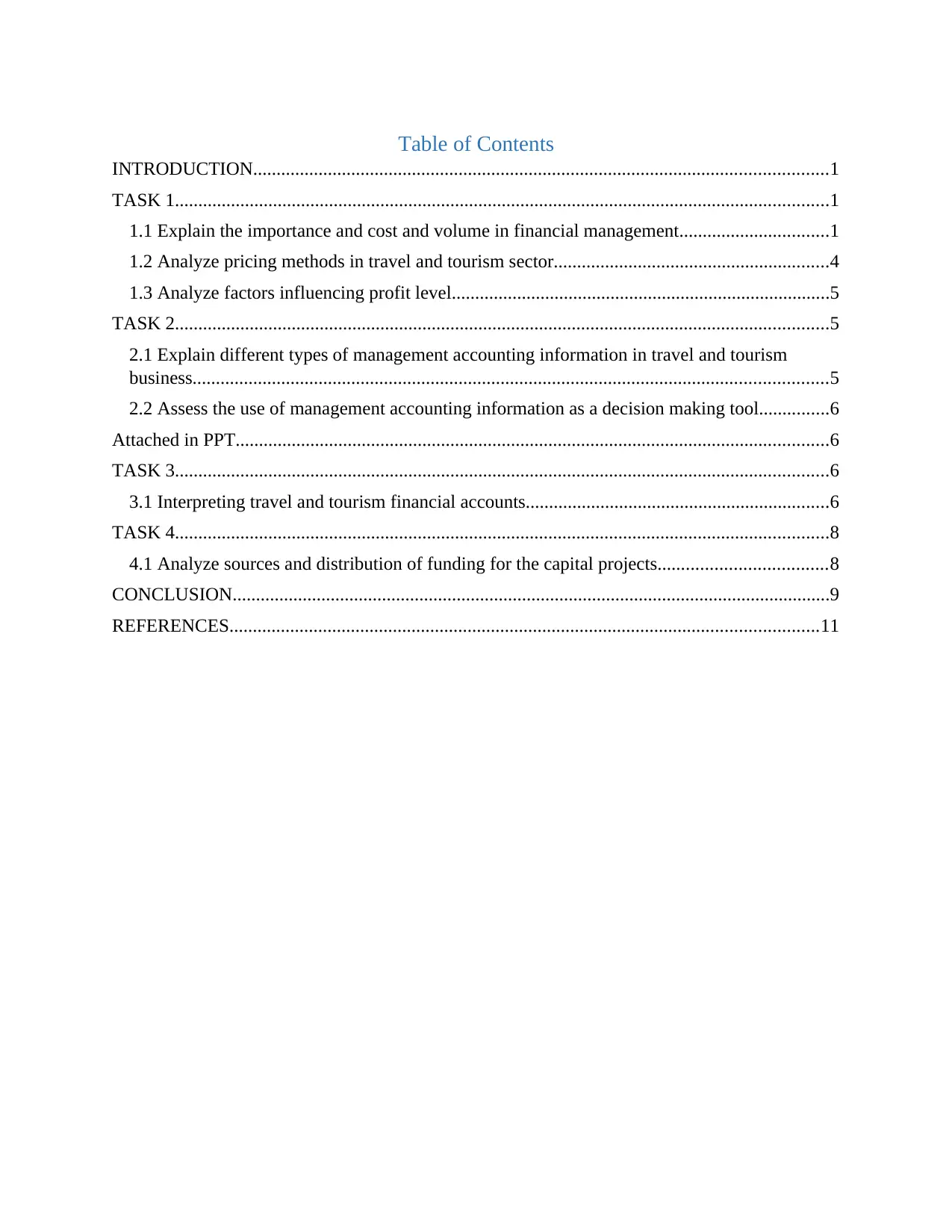
Table of Contents
INTRODUCTION...........................................................................................................................1
TASK 1............................................................................................................................................1
1.1 Explain the importance and cost and volume in financial management................................1
1.2 Analyze pricing methods in travel and tourism sector...........................................................4
1.3 Analyze factors influencing profit level.................................................................................5
TASK 2............................................................................................................................................5
2.1 Explain different types of management accounting information in travel and tourism
business........................................................................................................................................5
2.2 Assess the use of management accounting information as a decision making tool...............6
Attached in PPT...............................................................................................................................6
TASK 3............................................................................................................................................6
3.1 Interpreting travel and tourism financial accounts.................................................................6
TASK 4............................................................................................................................................8
4.1 Analyze sources and distribution of funding for the capital projects....................................8
CONCLUSION................................................................................................................................9
REFERENCES..............................................................................................................................11
INTRODUCTION...........................................................................................................................1
TASK 1............................................................................................................................................1
1.1 Explain the importance and cost and volume in financial management................................1
1.2 Analyze pricing methods in travel and tourism sector...........................................................4
1.3 Analyze factors influencing profit level.................................................................................5
TASK 2............................................................................................................................................5
2.1 Explain different types of management accounting information in travel and tourism
business........................................................................................................................................5
2.2 Assess the use of management accounting information as a decision making tool...............6
Attached in PPT...............................................................................................................................6
TASK 3............................................................................................................................................6
3.1 Interpreting travel and tourism financial accounts.................................................................6
TASK 4............................................................................................................................................8
4.1 Analyze sources and distribution of funding for the capital projects....................................8
CONCLUSION................................................................................................................................9
REFERENCES..............................................................................................................................11
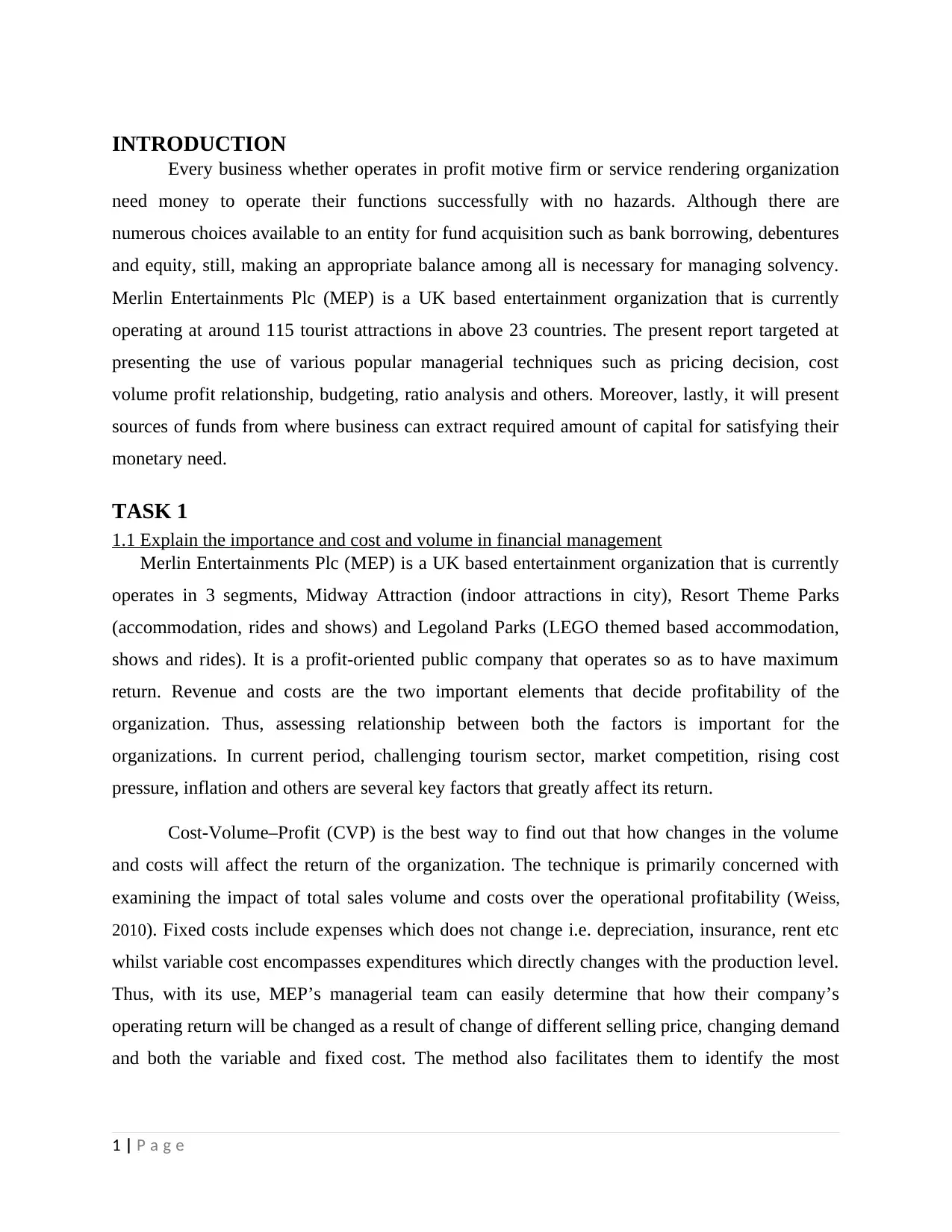
INTRODUCTION
Every business whether operates in profit motive firm or service rendering organization
need money to operate their functions successfully with no hazards. Although there are
numerous choices available to an entity for fund acquisition such as bank borrowing, debentures
and equity, still, making an appropriate balance among all is necessary for managing solvency.
Merlin Entertainments Plc (MEP) is a UK based entertainment organization that is currently
operating at around 115 tourist attractions in above 23 countries. The present report targeted at
presenting the use of various popular managerial techniques such as pricing decision, cost
volume profit relationship, budgeting, ratio analysis and others. Moreover, lastly, it will present
sources of funds from where business can extract required amount of capital for satisfying their
monetary need.
TASK 1
1.1 Explain the importance and cost and volume in financial management
Merlin Entertainments Plc (MEP) is a UK based entertainment organization that is currently
operates in 3 segments, Midway Attraction (indoor attractions in city), Resort Theme Parks
(accommodation, rides and shows) and Legoland Parks (LEGO themed based accommodation,
shows and rides). It is a profit-oriented public company that operates so as to have maximum
return. Revenue and costs are the two important elements that decide profitability of the
organization. Thus, assessing relationship between both the factors is important for the
organizations. In current period, challenging tourism sector, market competition, rising cost
pressure, inflation and others are several key factors that greatly affect its return.
Cost-Volume–Profit (CVP) is the best way to find out that how changes in the volume
and costs will affect the return of the organization. The technique is primarily concerned with
examining the impact of total sales volume and costs over the operational profitability (Weiss,
2010). Fixed costs include expenses which does not change i.e. depreciation, insurance, rent etc
whilst variable cost encompasses expenditures which directly changes with the production level.
Thus, with its use, MEP’s managerial team can easily determine that how their company’s
operating return will be changed as a result of change of different selling price, changing demand
and both the variable and fixed cost. The method also facilitates them to identify the most
1 | P a g e
Every business whether operates in profit motive firm or service rendering organization
need money to operate their functions successfully with no hazards. Although there are
numerous choices available to an entity for fund acquisition such as bank borrowing, debentures
and equity, still, making an appropriate balance among all is necessary for managing solvency.
Merlin Entertainments Plc (MEP) is a UK based entertainment organization that is currently
operating at around 115 tourist attractions in above 23 countries. The present report targeted at
presenting the use of various popular managerial techniques such as pricing decision, cost
volume profit relationship, budgeting, ratio analysis and others. Moreover, lastly, it will present
sources of funds from where business can extract required amount of capital for satisfying their
monetary need.
TASK 1
1.1 Explain the importance and cost and volume in financial management
Merlin Entertainments Plc (MEP) is a UK based entertainment organization that is currently
operates in 3 segments, Midway Attraction (indoor attractions in city), Resort Theme Parks
(accommodation, rides and shows) and Legoland Parks (LEGO themed based accommodation,
shows and rides). It is a profit-oriented public company that operates so as to have maximum
return. Revenue and costs are the two important elements that decide profitability of the
organization. Thus, assessing relationship between both the factors is important for the
organizations. In current period, challenging tourism sector, market competition, rising cost
pressure, inflation and others are several key factors that greatly affect its return.
Cost-Volume–Profit (CVP) is the best way to find out that how changes in the volume
and costs will affect the return of the organization. The technique is primarily concerned with
examining the impact of total sales volume and costs over the operational profitability (Weiss,
2010). Fixed costs include expenses which does not change i.e. depreciation, insurance, rent etc
whilst variable cost encompasses expenditures which directly changes with the production level.
Thus, with its use, MEP’s managerial team can easily determine that how their company’s
operating return will be changed as a result of change of different selling price, changing demand
and both the variable and fixed cost. The method also facilitates them to identify the most
1 | P a g e
⊘ This is a preview!⊘
Do you want full access?
Subscribe today to unlock all pages.

Trusted by 1+ million students worldwide
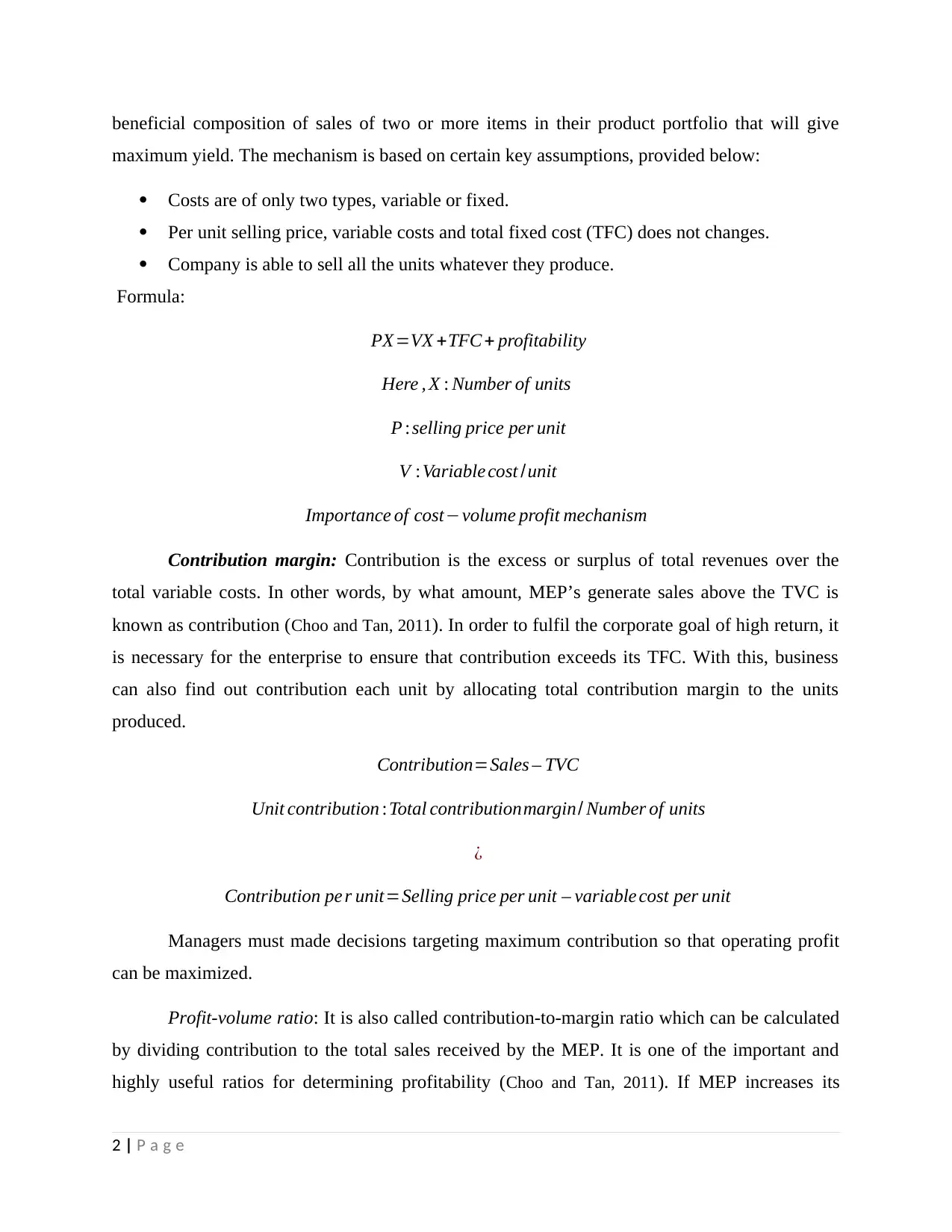
beneficial composition of sales of two or more items in their product portfolio that will give
maximum yield. The mechanism is based on certain key assumptions, provided below:
Costs are of only two types, variable or fixed.
Per unit selling price, variable costs and total fixed cost (TFC) does not changes.
Company is able to sell all the units whatever they produce.
Formula:
PX=VX +TFC + profitability
Here , X : Number of units
P :selling price per unit
V :Variable cost /unit
Importance of cost−volume profit mechanism
Contribution margin: Contribution is the excess or surplus of total revenues over the
total variable costs. In other words, by what amount, MEP’s generate sales above the TVC is
known as contribution (Choo and Tan, 2011). In order to fulfil the corporate goal of high return, it
is necessary for the enterprise to ensure that contribution exceeds its TFC. With this, business
can also find out contribution each unit by allocating total contribution margin to the units
produced.
Contribution=Sales – TVC
Unit contribution :Total contributionmargin/ Number of units
¿
Contribution pe r unit=Selling price per unit – variable cost per unit
Managers must made decisions targeting maximum contribution so that operating profit
can be maximized.
Profit-volume ratio: It is also called contribution-to-margin ratio which can be calculated
by dividing contribution to the total sales received by the MEP. It is one of the important and
highly useful ratios for determining profitability (Choo and Tan, 2011). If MEP increases its
2 | P a g e
maximum yield. The mechanism is based on certain key assumptions, provided below:
Costs are of only two types, variable or fixed.
Per unit selling price, variable costs and total fixed cost (TFC) does not changes.
Company is able to sell all the units whatever they produce.
Formula:
PX=VX +TFC + profitability
Here , X : Number of units
P :selling price per unit
V :Variable cost /unit
Importance of cost−volume profit mechanism
Contribution margin: Contribution is the excess or surplus of total revenues over the
total variable costs. In other words, by what amount, MEP’s generate sales above the TVC is
known as contribution (Choo and Tan, 2011). In order to fulfil the corporate goal of high return, it
is necessary for the enterprise to ensure that contribution exceeds its TFC. With this, business
can also find out contribution each unit by allocating total contribution margin to the units
produced.
Contribution=Sales – TVC
Unit contribution :Total contributionmargin/ Number of units
¿
Contribution pe r unit=Selling price per unit – variable cost per unit
Managers must made decisions targeting maximum contribution so that operating profit
can be maximized.
Profit-volume ratio: It is also called contribution-to-margin ratio which can be calculated
by dividing contribution to the total sales received by the MEP. It is one of the important and
highly useful ratios for determining profitability (Choo and Tan, 2011). If MEP increases its
2 | P a g e
Paraphrase This Document
Need a fresh take? Get an instant paraphrase of this document with our AI Paraphraser
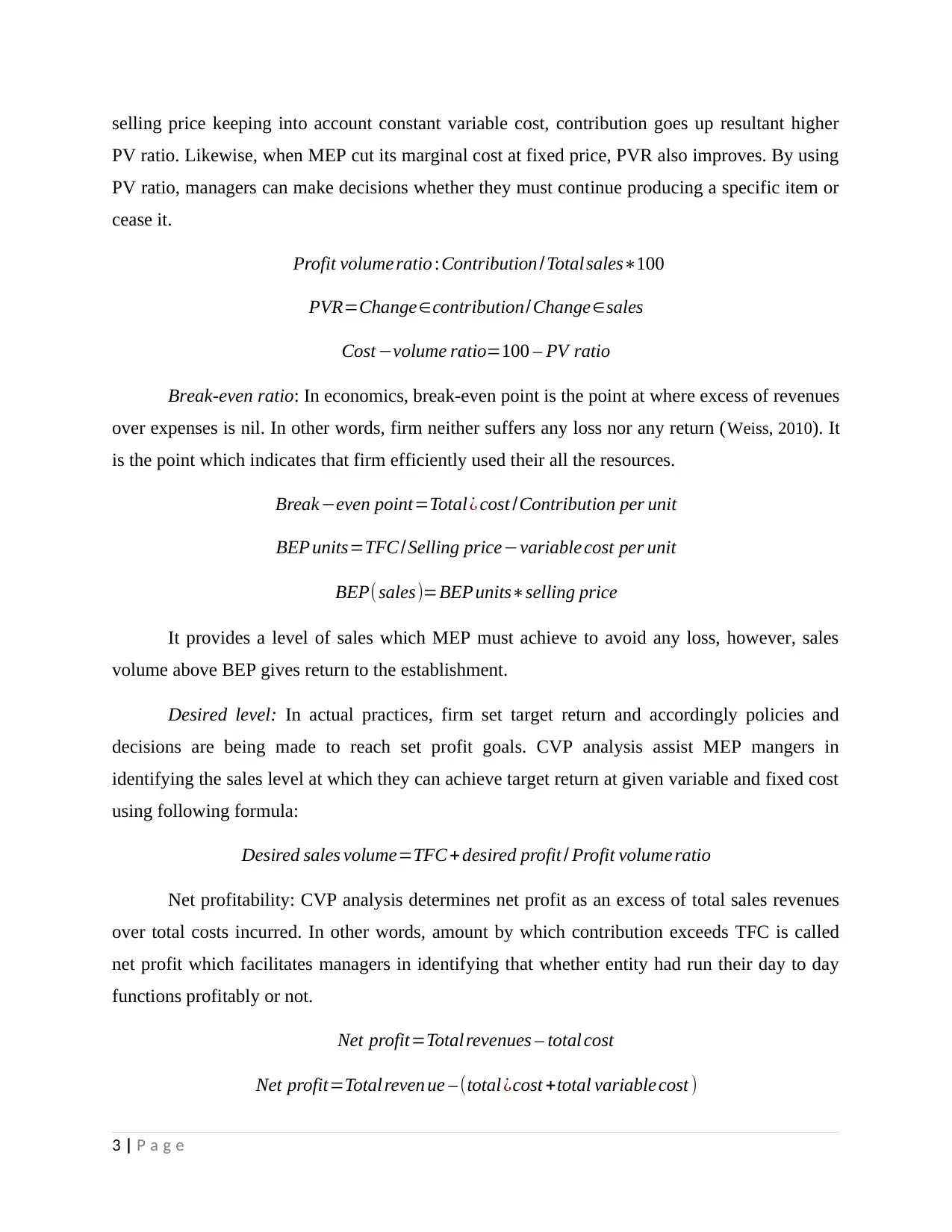
selling price keeping into account constant variable cost, contribution goes up resultant higher
PV ratio. Likewise, when MEP cut its marginal cost at fixed price, PVR also improves. By using
PV ratio, managers can make decisions whether they must continue producing a specific item or
cease it.
Profit volume ratio :Contribution /Total sales∗100
PVR=Change∈contribution/Change∈sales
Cost −volume ratio=100 – PV ratio
Break-even ratio: In economics, break-even point is the point at where excess of revenues
over expenses is nil. In other words, firm neither suffers any loss nor any return (Weiss, 2010). It
is the point which indicates that firm efficiently used their all the resources.
Break−even point=Total¿ cost /Contribution per unit
BEP units=TFC /Selling price−variable cost per unit
BEP( sales)=BEP units∗selling price
It provides a level of sales which MEP must achieve to avoid any loss, however, sales
volume above BEP gives return to the establishment.
Desired level: In actual practices, firm set target return and accordingly policies and
decisions are being made to reach set profit goals. CVP analysis assist MEP mangers in
identifying the sales level at which they can achieve target return at given variable and fixed cost
using following formula:
Desired sales volume=TFC + desired profit / Profit volume ratio
Net profitability: CVP analysis determines net profit as an excess of total sales revenues
over total costs incurred. In other words, amount by which contribution exceeds TFC is called
net profit which facilitates managers in identifying that whether entity had run their day to day
functions profitably or not.
Net profit=Total revenues – total cost
Net profit=Total reven ue – (total ¿cost +total variable cost )
3 | P a g e
PV ratio. Likewise, when MEP cut its marginal cost at fixed price, PVR also improves. By using
PV ratio, managers can make decisions whether they must continue producing a specific item or
cease it.
Profit volume ratio :Contribution /Total sales∗100
PVR=Change∈contribution/Change∈sales
Cost −volume ratio=100 – PV ratio
Break-even ratio: In economics, break-even point is the point at where excess of revenues
over expenses is nil. In other words, firm neither suffers any loss nor any return (Weiss, 2010). It
is the point which indicates that firm efficiently used their all the resources.
Break−even point=Total¿ cost /Contribution per unit
BEP units=TFC /Selling price−variable cost per unit
BEP( sales)=BEP units∗selling price
It provides a level of sales which MEP must achieve to avoid any loss, however, sales
volume above BEP gives return to the establishment.
Desired level: In actual practices, firm set target return and accordingly policies and
decisions are being made to reach set profit goals. CVP analysis assist MEP mangers in
identifying the sales level at which they can achieve target return at given variable and fixed cost
using following formula:
Desired sales volume=TFC + desired profit / Profit volume ratio
Net profitability: CVP analysis determines net profit as an excess of total sales revenues
over total costs incurred. In other words, amount by which contribution exceeds TFC is called
net profit which facilitates managers in identifying that whether entity had run their day to day
functions profitably or not.
Net profit=Total revenues – total cost
Net profit=Total reven ue – (total ¿cost +total variable cost )
3 | P a g e
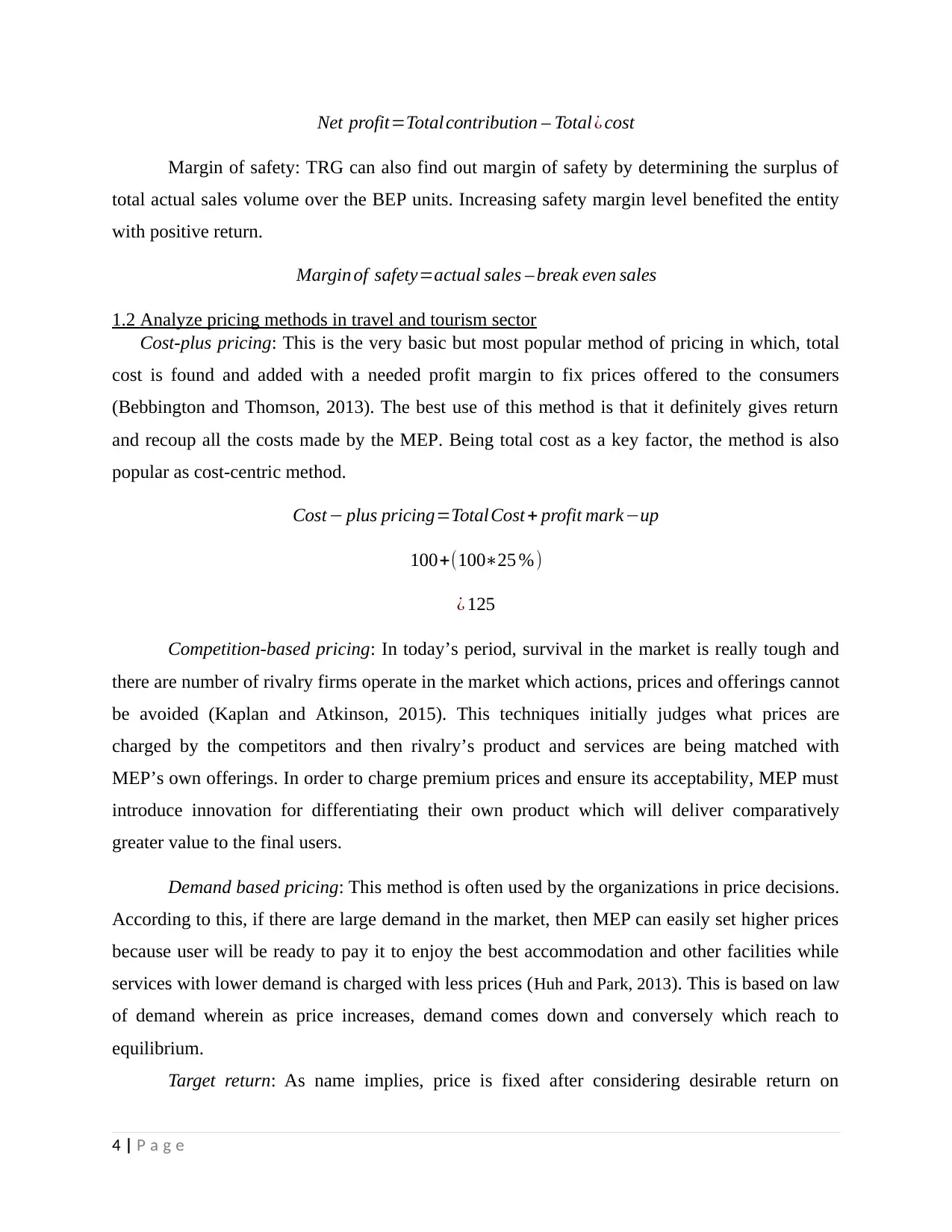
Net profit=Total contribution – Total ¿ cost
Margin of safety: TRG can also find out margin of safety by determining the surplus of
total actual sales volume over the BEP units. Increasing safety margin level benefited the entity
with positive return.
Margin of safety=actual sales – break even sales
1.2 Analyze pricing methods in travel and tourism sector
Cost-plus pricing: This is the very basic but most popular method of pricing in which, total
cost is found and added with a needed profit margin to fix prices offered to the consumers
(Bebbington and Thomson, 2013). The best use of this method is that it definitely gives return
and recoup all the costs made by the MEP. Being total cost as a key factor, the method is also
popular as cost-centric method.
Cost − plus pricing=Total Cost + profit mark−up
100+(100∗25 % )
¿ 125
Competition-based pricing: In today’s period, survival in the market is really tough and
there are number of rivalry firms operate in the market which actions, prices and offerings cannot
be avoided (Kaplan and Atkinson, 2015). This techniques initially judges what prices are
charged by the competitors and then rivalry’s product and services are being matched with
MEP’s own offerings. In order to charge premium prices and ensure its acceptability, MEP must
introduce innovation for differentiating their own product which will deliver comparatively
greater value to the final users.
Demand based pricing: This method is often used by the organizations in price decisions.
According to this, if there are large demand in the market, then MEP can easily set higher prices
because user will be ready to pay it to enjoy the best accommodation and other facilities while
services with lower demand is charged with less prices (Huh and Park, 2013). This is based on law
of demand wherein as price increases, demand comes down and conversely which reach to
equilibrium.
Target return: As name implies, price is fixed after considering desirable return on
4 | P a g e
Margin of safety: TRG can also find out margin of safety by determining the surplus of
total actual sales volume over the BEP units. Increasing safety margin level benefited the entity
with positive return.
Margin of safety=actual sales – break even sales
1.2 Analyze pricing methods in travel and tourism sector
Cost-plus pricing: This is the very basic but most popular method of pricing in which, total
cost is found and added with a needed profit margin to fix prices offered to the consumers
(Bebbington and Thomson, 2013). The best use of this method is that it definitely gives return
and recoup all the costs made by the MEP. Being total cost as a key factor, the method is also
popular as cost-centric method.
Cost − plus pricing=Total Cost + profit mark−up
100+(100∗25 % )
¿ 125
Competition-based pricing: In today’s period, survival in the market is really tough and
there are number of rivalry firms operate in the market which actions, prices and offerings cannot
be avoided (Kaplan and Atkinson, 2015). This techniques initially judges what prices are
charged by the competitors and then rivalry’s product and services are being matched with
MEP’s own offerings. In order to charge premium prices and ensure its acceptability, MEP must
introduce innovation for differentiating their own product which will deliver comparatively
greater value to the final users.
Demand based pricing: This method is often used by the organizations in price decisions.
According to this, if there are large demand in the market, then MEP can easily set higher prices
because user will be ready to pay it to enjoy the best accommodation and other facilities while
services with lower demand is charged with less prices (Huh and Park, 2013). This is based on law
of demand wherein as price increases, demand comes down and conversely which reach to
equilibrium.
Target return: As name implies, price is fixed after considering desirable return on
4 | P a g e
⊘ This is a preview!⊘
Do you want full access?
Subscribe today to unlock all pages.

Trusted by 1+ million students worldwide
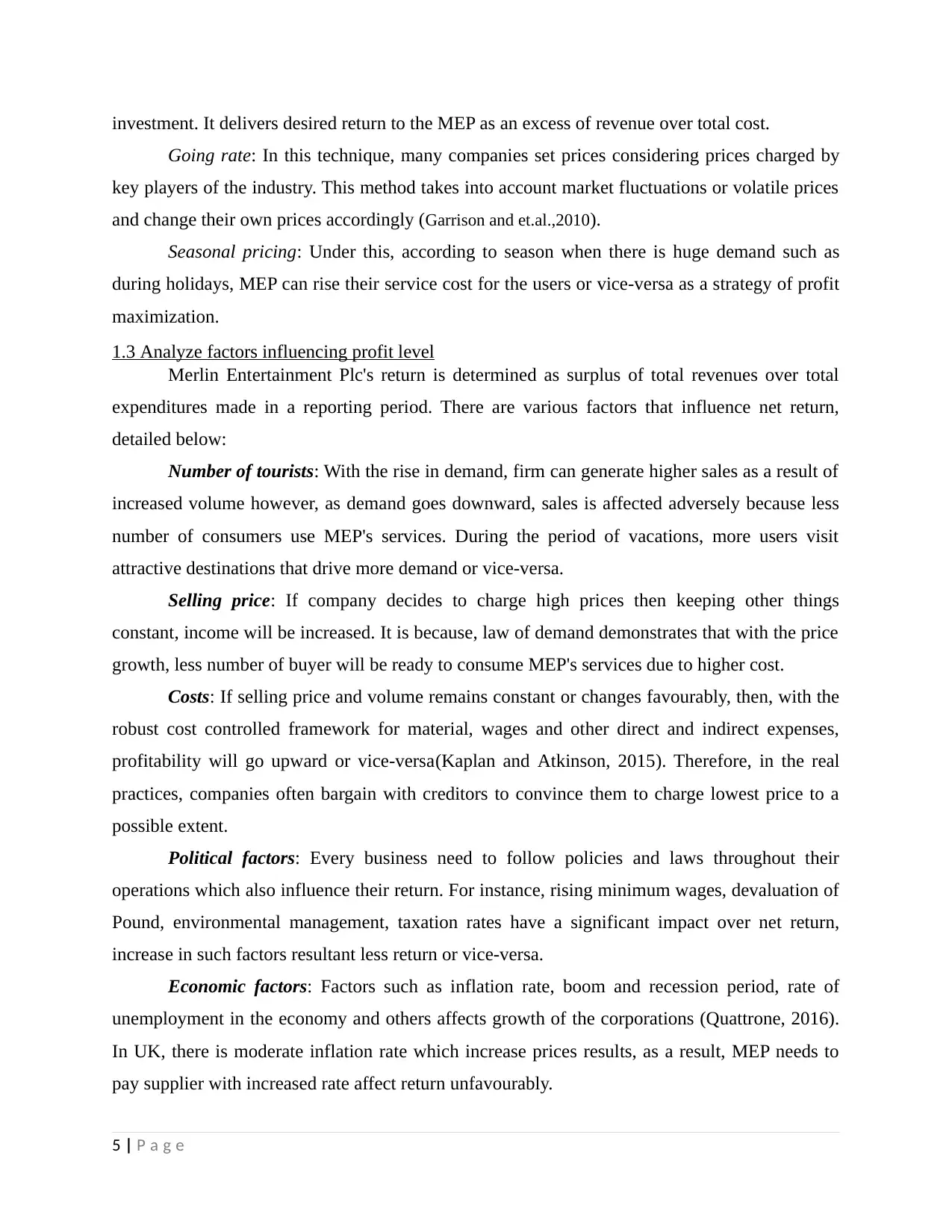
investment. It delivers desired return to the MEP as an excess of revenue over total cost.
Going rate: In this technique, many companies set prices considering prices charged by
key players of the industry. This method takes into account market fluctuations or volatile prices
and change their own prices accordingly (Garrison and et.al.,2010).
Seasonal pricing: Under this, according to season when there is huge demand such as
during holidays, MEP can rise their service cost for the users or vice-versa as a strategy of profit
maximization.
1.3 Analyze factors influencing profit level
Merlin Entertainment Plc's return is determined as surplus of total revenues over total
expenditures made in a reporting period. There are various factors that influence net return,
detailed below:
Number of tourists: With the rise in demand, firm can generate higher sales as a result of
increased volume however, as demand goes downward, sales is affected adversely because less
number of consumers use MEP's services. During the period of vacations, more users visit
attractive destinations that drive more demand or vice-versa.
Selling price: If company decides to charge high prices then keeping other things
constant, income will be increased. It is because, law of demand demonstrates that with the price
growth, less number of buyer will be ready to consume MEP's services due to higher cost.
Costs: If selling price and volume remains constant or changes favourably, then, with the
robust cost controlled framework for material, wages and other direct and indirect expenses,
profitability will go upward or vice-versa(Kaplan and Atkinson, 2015). Therefore, in the real
practices, companies often bargain with creditors to convince them to charge lowest price to a
possible extent.
Political factors: Every business need to follow policies and laws throughout their
operations which also influence their return. For instance, rising minimum wages, devaluation of
Pound, environmental management, taxation rates have a significant impact over net return,
increase in such factors resultant less return or vice-versa.
Economic factors: Factors such as inflation rate, boom and recession period, rate of
unemployment in the economy and others affects growth of the corporations (Quattrone, 2016).
In UK, there is moderate inflation rate which increase prices results, as a result, MEP needs to
pay supplier with increased rate affect return unfavourably.
5 | P a g e
Going rate: In this technique, many companies set prices considering prices charged by
key players of the industry. This method takes into account market fluctuations or volatile prices
and change their own prices accordingly (Garrison and et.al.,2010).
Seasonal pricing: Under this, according to season when there is huge demand such as
during holidays, MEP can rise their service cost for the users or vice-versa as a strategy of profit
maximization.
1.3 Analyze factors influencing profit level
Merlin Entertainment Plc's return is determined as surplus of total revenues over total
expenditures made in a reporting period. There are various factors that influence net return,
detailed below:
Number of tourists: With the rise in demand, firm can generate higher sales as a result of
increased volume however, as demand goes downward, sales is affected adversely because less
number of consumers use MEP's services. During the period of vacations, more users visit
attractive destinations that drive more demand or vice-versa.
Selling price: If company decides to charge high prices then keeping other things
constant, income will be increased. It is because, law of demand demonstrates that with the price
growth, less number of buyer will be ready to consume MEP's services due to higher cost.
Costs: If selling price and volume remains constant or changes favourably, then, with the
robust cost controlled framework for material, wages and other direct and indirect expenses,
profitability will go upward or vice-versa(Kaplan and Atkinson, 2015). Therefore, in the real
practices, companies often bargain with creditors to convince them to charge lowest price to a
possible extent.
Political factors: Every business need to follow policies and laws throughout their
operations which also influence their return. For instance, rising minimum wages, devaluation of
Pound, environmental management, taxation rates have a significant impact over net return,
increase in such factors resultant less return or vice-versa.
Economic factors: Factors such as inflation rate, boom and recession period, rate of
unemployment in the economy and others affects growth of the corporations (Quattrone, 2016).
In UK, there is moderate inflation rate which increase prices results, as a result, MEP needs to
pay supplier with increased rate affect return unfavourably.
5 | P a g e
Paraphrase This Document
Need a fresh take? Get an instant paraphrase of this document with our AI Paraphraser
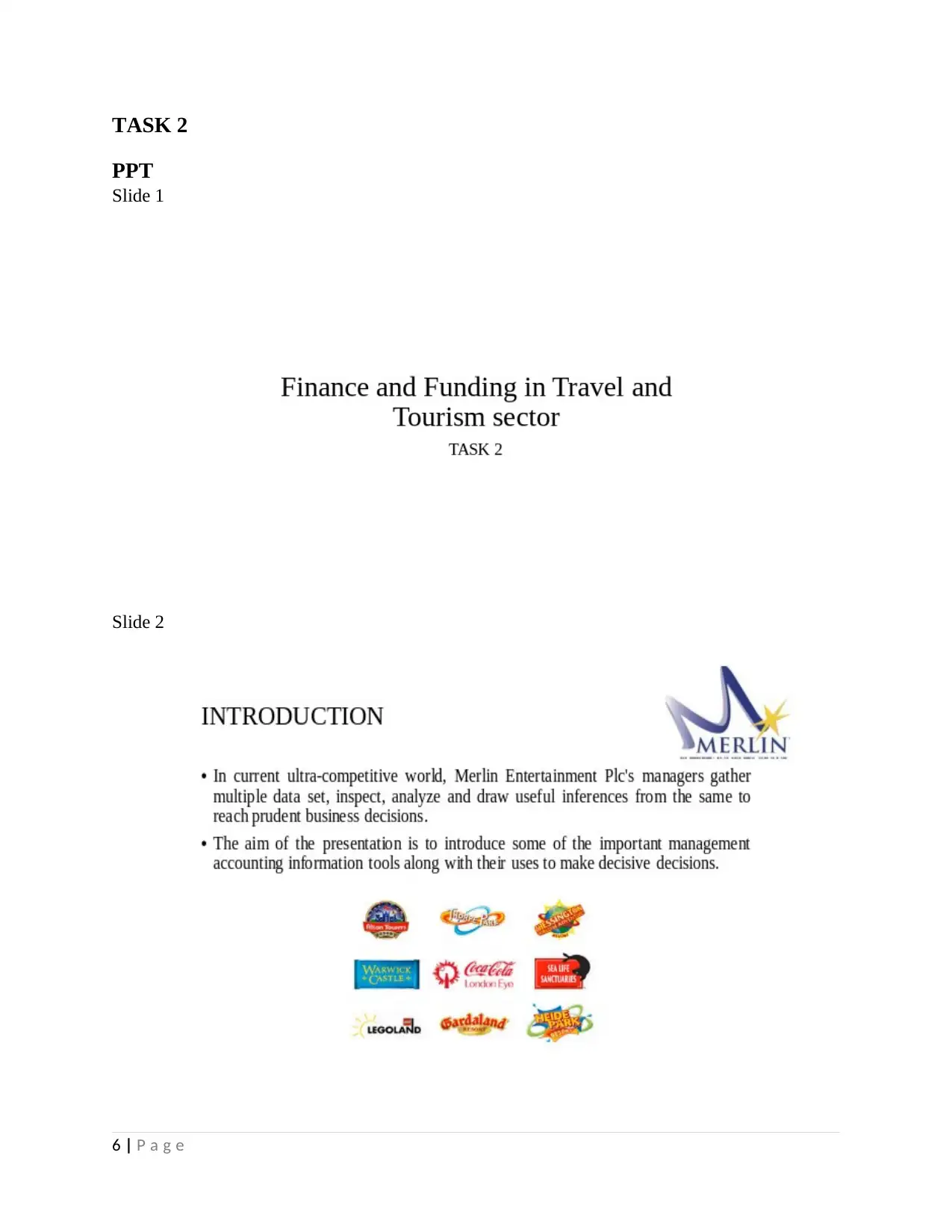
TASK 2
PPT
Slide 1
Slide 2
6 | P a g e
PPT
Slide 1
Slide 2
6 | P a g e
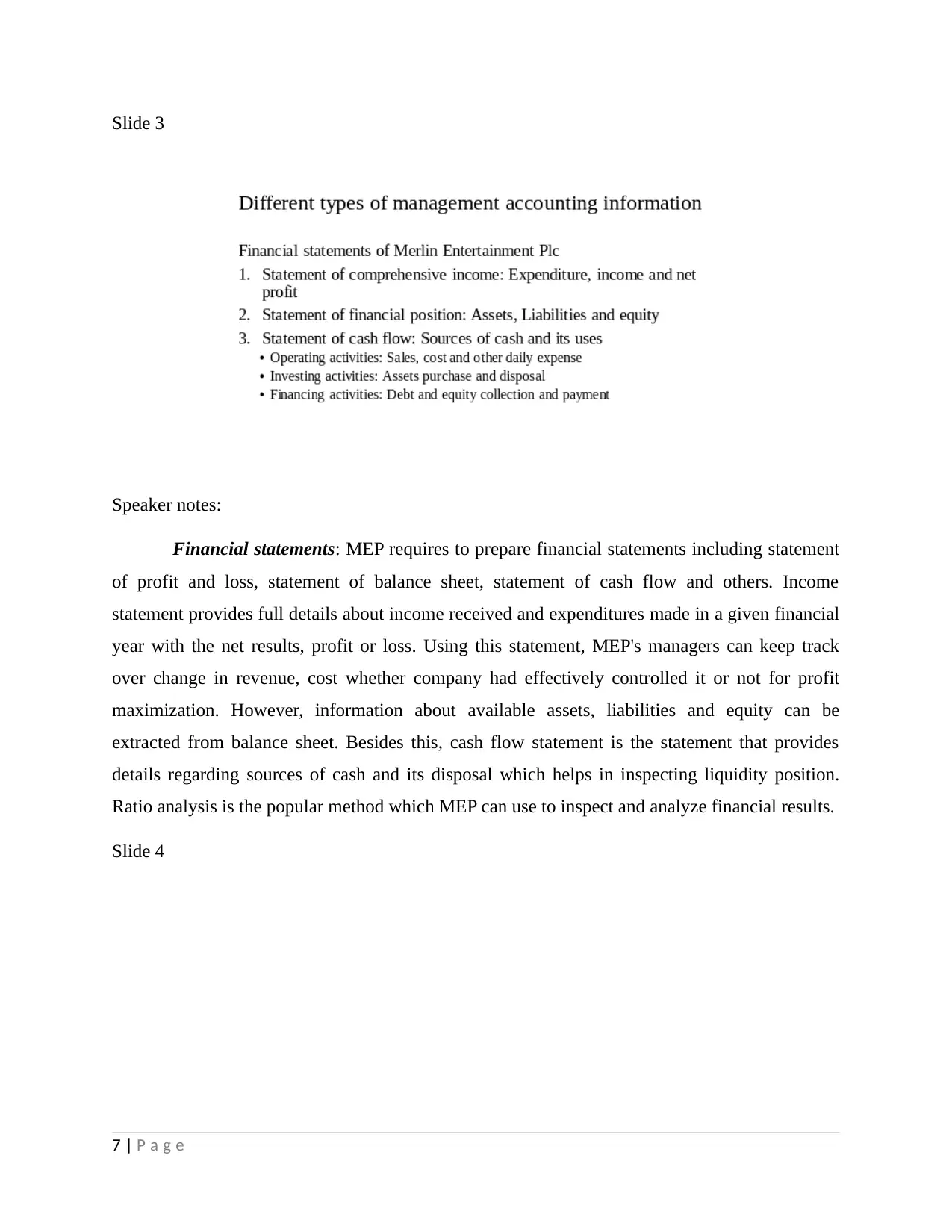
Slide 3
Speaker notes:
Financial statements: MEP requires to prepare financial statements including statement
of profit and loss, statement of balance sheet, statement of cash flow and others. Income
statement provides full details about income received and expenditures made in a given financial
year with the net results, profit or loss. Using this statement, MEP's managers can keep track
over change in revenue, cost whether company had effectively controlled it or not for profit
maximization. However, information about available assets, liabilities and equity can be
extracted from balance sheet. Besides this, cash flow statement is the statement that provides
details regarding sources of cash and its disposal which helps in inspecting liquidity position.
Ratio analysis is the popular method which MEP can use to inspect and analyze financial results.
Slide 4
7 | P a g e
Speaker notes:
Financial statements: MEP requires to prepare financial statements including statement
of profit and loss, statement of balance sheet, statement of cash flow and others. Income
statement provides full details about income received and expenditures made in a given financial
year with the net results, profit or loss. Using this statement, MEP's managers can keep track
over change in revenue, cost whether company had effectively controlled it or not for profit
maximization. However, information about available assets, liabilities and equity can be
extracted from balance sheet. Besides this, cash flow statement is the statement that provides
details regarding sources of cash and its disposal which helps in inspecting liquidity position.
Ratio analysis is the popular method which MEP can use to inspect and analyze financial results.
Slide 4
7 | P a g e
⊘ This is a preview!⊘
Do you want full access?
Subscribe today to unlock all pages.

Trusted by 1+ million students worldwide
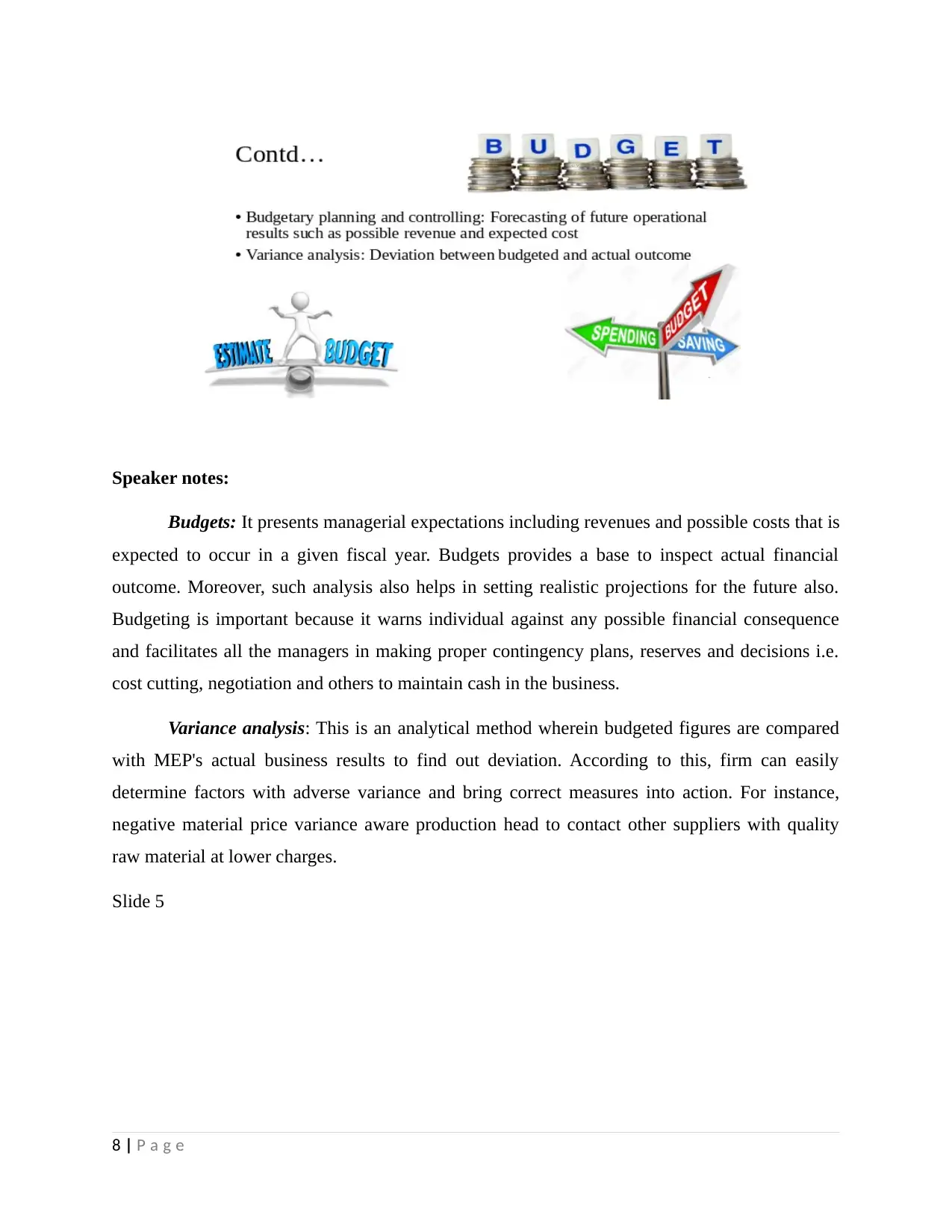
Speaker notes:
Budgets: It presents managerial expectations including revenues and possible costs that is
expected to occur in a given fiscal year. Budgets provides a base to inspect actual financial
outcome. Moreover, such analysis also helps in setting realistic projections for the future also.
Budgeting is important because it warns individual against any possible financial consequence
and facilitates all the managers in making proper contingency plans, reserves and decisions i.e.
cost cutting, negotiation and others to maintain cash in the business.
Variance analysis: This is an analytical method wherein budgeted figures are compared
with MEP's actual business results to find out deviation. According to this, firm can easily
determine factors with adverse variance and bring correct measures into action. For instance,
negative material price variance aware production head to contact other suppliers with quality
raw material at lower charges.
Slide 5
8 | P a g e
Budgets: It presents managerial expectations including revenues and possible costs that is
expected to occur in a given fiscal year. Budgets provides a base to inspect actual financial
outcome. Moreover, such analysis also helps in setting realistic projections for the future also.
Budgeting is important because it warns individual against any possible financial consequence
and facilitates all the managers in making proper contingency plans, reserves and decisions i.e.
cost cutting, negotiation and others to maintain cash in the business.
Variance analysis: This is an analytical method wherein budgeted figures are compared
with MEP's actual business results to find out deviation. According to this, firm can easily
determine factors with adverse variance and bring correct measures into action. For instance,
negative material price variance aware production head to contact other suppliers with quality
raw material at lower charges.
Slide 5
8 | P a g e
Paraphrase This Document
Need a fresh take? Get an instant paraphrase of this document with our AI Paraphraser
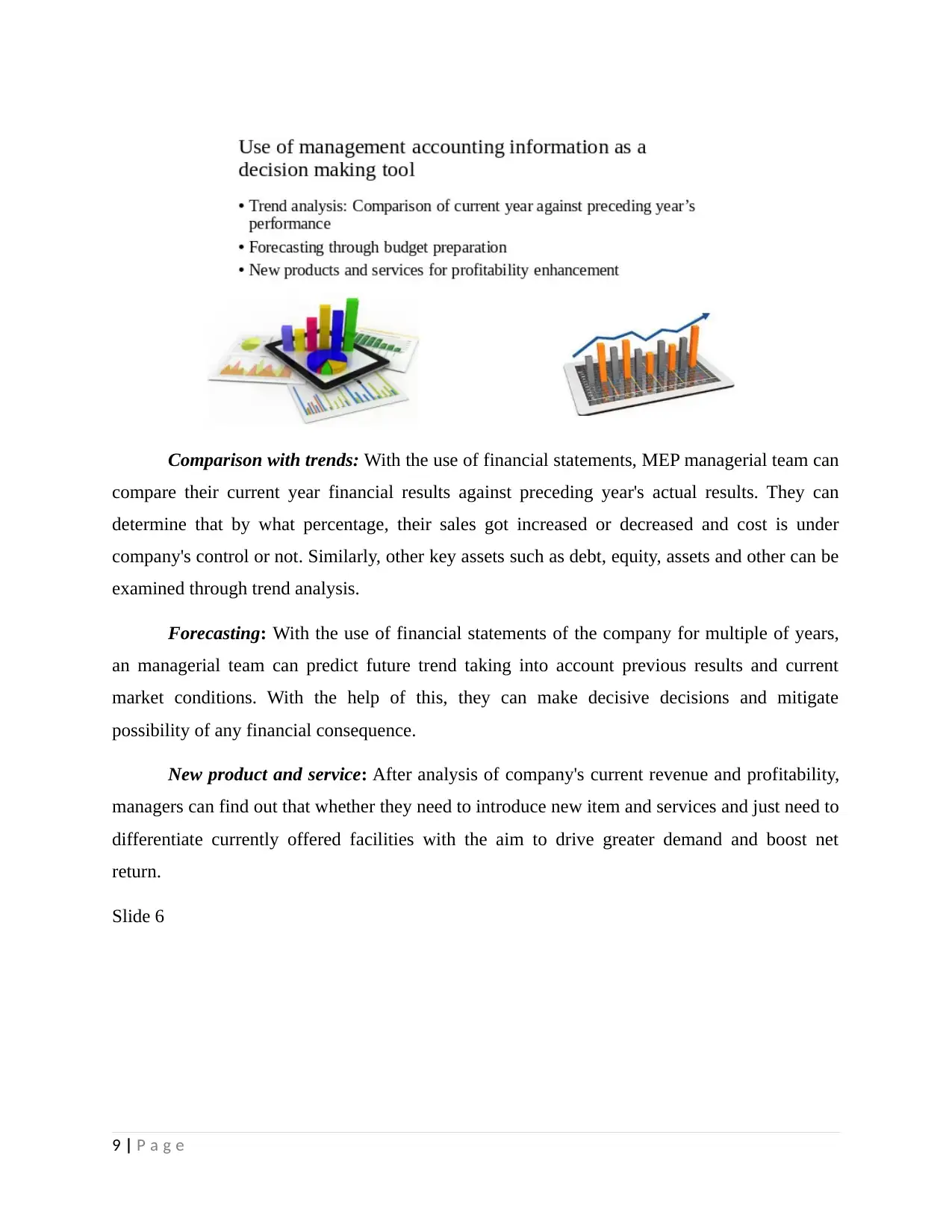
Comparison with trends: With the use of financial statements, MEP managerial team can
compare their current year financial results against preceding year's actual results. They can
determine that by what percentage, their sales got increased or decreased and cost is under
company's control or not. Similarly, other key assets such as debt, equity, assets and other can be
examined through trend analysis.
Forecasting: With the use of financial statements of the company for multiple of years,
an managerial team can predict future trend taking into account previous results and current
market conditions. With the help of this, they can make decisive decisions and mitigate
possibility of any financial consequence.
New product and service: After analysis of company's current revenue and profitability,
managers can find out that whether they need to introduce new item and services and just need to
differentiate currently offered facilities with the aim to drive greater demand and boost net
return.
Slide 6
9 | P a g e
compare their current year financial results against preceding year's actual results. They can
determine that by what percentage, their sales got increased or decreased and cost is under
company's control or not. Similarly, other key assets such as debt, equity, assets and other can be
examined through trend analysis.
Forecasting: With the use of financial statements of the company for multiple of years,
an managerial team can predict future trend taking into account previous results and current
market conditions. With the help of this, they can make decisive decisions and mitigate
possibility of any financial consequence.
New product and service: After analysis of company's current revenue and profitability,
managers can find out that whether they need to introduce new item and services and just need to
differentiate currently offered facilities with the aim to drive greater demand and boost net
return.
Slide 6
9 | P a g e
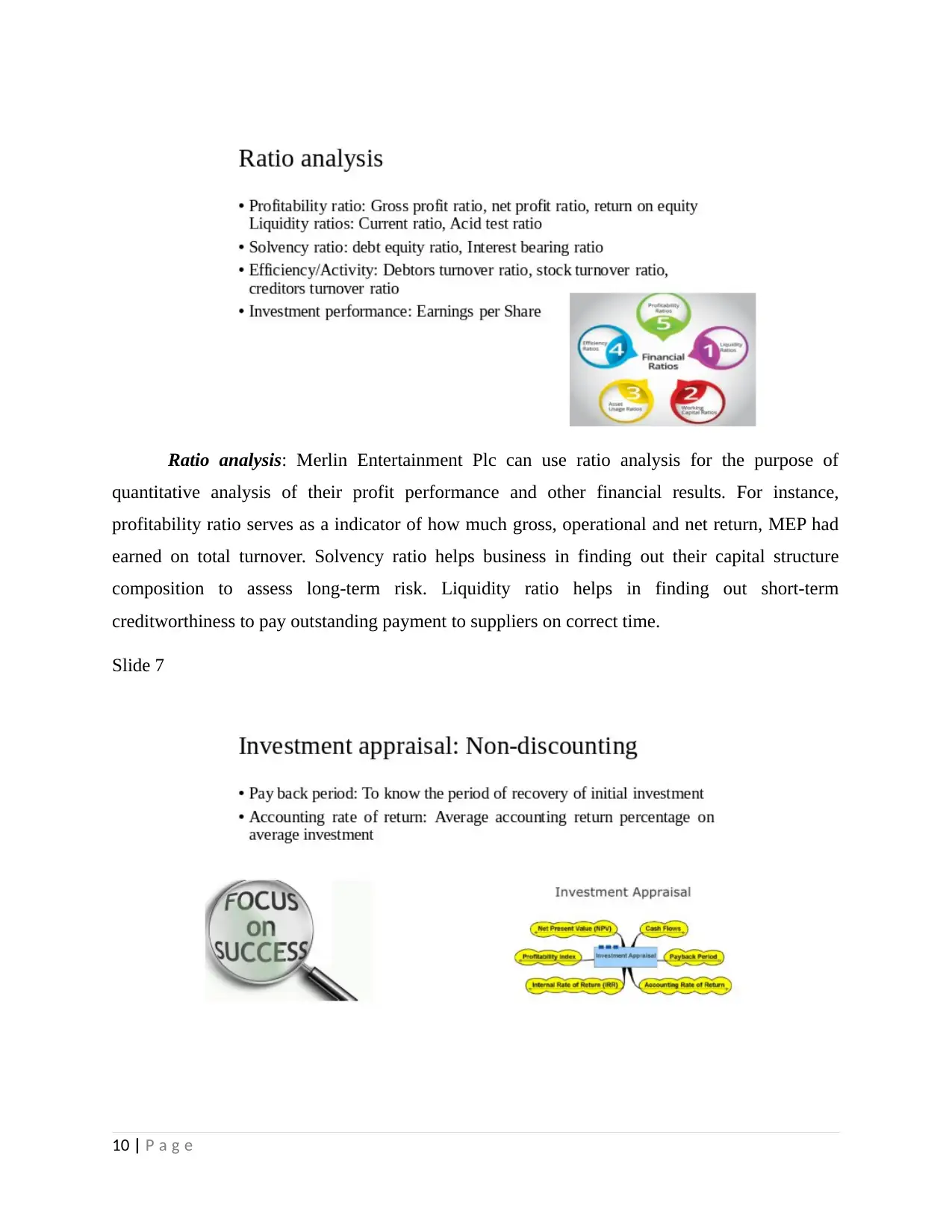
Ratio analysis: Merlin Entertainment Plc can use ratio analysis for the purpose of
quantitative analysis of their profit performance and other financial results. For instance,
profitability ratio serves as a indicator of how much gross, operational and net return, MEP had
earned on total turnover. Solvency ratio helps business in finding out their capital structure
composition to assess long-term risk. Liquidity ratio helps in finding out short-term
creditworthiness to pay outstanding payment to suppliers on correct time.
Slide 7
10 | P a g e
quantitative analysis of their profit performance and other financial results. For instance,
profitability ratio serves as a indicator of how much gross, operational and net return, MEP had
earned on total turnover. Solvency ratio helps business in finding out their capital structure
composition to assess long-term risk. Liquidity ratio helps in finding out short-term
creditworthiness to pay outstanding payment to suppliers on correct time.
Slide 7
10 | P a g e
⊘ This is a preview!⊘
Do you want full access?
Subscribe today to unlock all pages.

Trusted by 1+ million students worldwide
1 out of 21
Related Documents
Your All-in-One AI-Powered Toolkit for Academic Success.
+13062052269
info@desklib.com
Available 24*7 on WhatsApp / Email
![[object Object]](/_next/static/media/star-bottom.7253800d.svg)
Unlock your academic potential
Copyright © 2020–2025 A2Z Services. All Rights Reserved. Developed and managed by ZUCOL.





